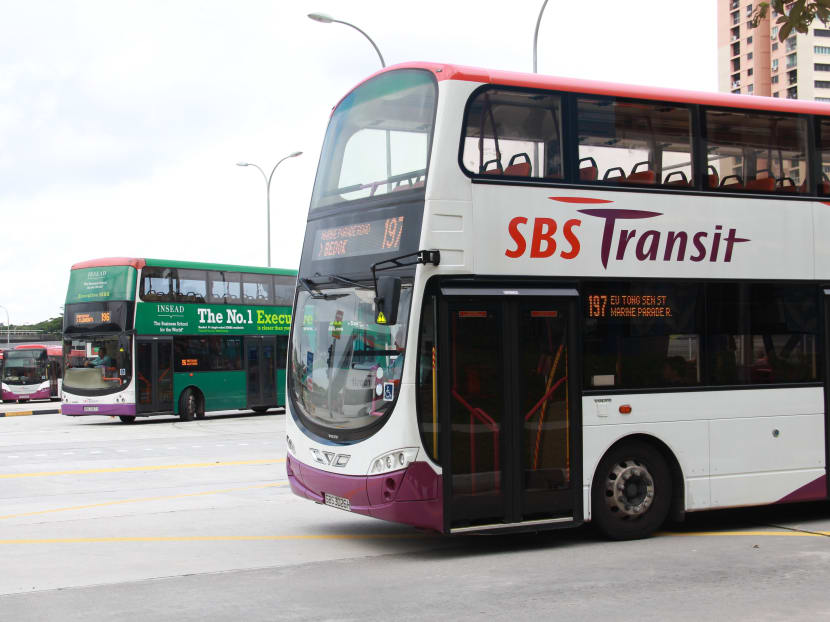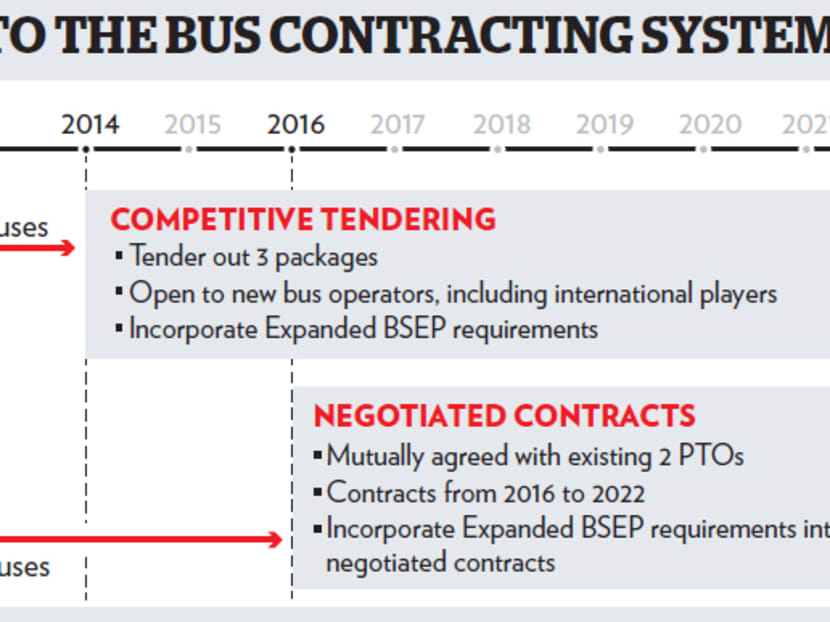Major overhaul for public bus services
SINGAPORE — The public bus industry will be radically overhauled, in what analysts have described as the biggest transport policy revamp in decades.
SINGAPORE — The public bus industry will be radically overhauled, in what analysts have described as the biggest transport policy revamp in decades.
After several previous attempts to address persistent grouses from commuters over route coverage and waiting times, the Land Transport Authority (LTA) announced yesterday that, from the second half of this year, the Government will embark on a bus contracting model that will see operators bidding for a package of routes through competitive tendering.
The Government will own, provide and fund all bus operating assets and infrastructure such as buses, depots, interchanges, bus monitoring and operations systems, and fare systems.
The LTA will determine the bus services to be provided and the service standards, and operators will bid for the right to operate these services.
Revenues from fares will go to the Government, while operators will pocket the non-fare revenues from advertising on buses or commercial rentals at interchanges, for example, on top of the amount it is paid by the Government to run the services.
Higher service standards will be enforced in the new contracts. Under the contracting model, 45 per cent of the bus services will have shorter waiting time during peak periods. The waiting period for all buses should not exceed 15 minutes during peak periods.
The LTA added that under the current privatised model, operators may not run services if these are assessed to be unprofitable. Having studied the London and Australian bus contracting models over the past two years, the LTA noted that these models have run well and brought improvements to services.
The LTA stressed that the job security and welfare of bus drivers and workers will be a key priority. It will work with the National Transport Workers’ Union and the operators to ensure a smooth transition for affected employees. Under the new model, an operator is required to make employment offers to workers previously hired by its rival on terms that are not worse if it wins the tender for a package of routes.
Who will pay for higher service levels?
Transport analysts lauded the move as commuters will benefit from the expected higher service levels.
However, the new system would be “very expensive” for the Government, noted Dr Park Byung-joon, head of the Urban Transport Management Programme at SIM University. “To be able to achieve the standard the Government is going to ask for, it will probably cost more than the fares we are currently paying,” he said, adding that it is unlikely the additional costs will be fully passed on to the commuters. Hence, the amount of taxpayers’ monies the Government spends on public transport could increase significantly, he noted.
In London, bus fares have gone up by 59 per cent since 2005, while the number of journeys increased by about a quarter over the same period.
In Perth, taxpayers pay for two-thirds of the costs of providing the bus and rail systems while commuters pay the remainder. Mr Colin Barnett, the Premier of Western Australia, recently said commuters would need to pay as much as half of the cost eventually.
The LTA stressed that the Government will continue to ensure the affordability of public transport fares.
Speaking on Channel NewsAsia’s Talking Point programme last night, LTA director of policy Looi Teik Soon said the practice of having the Public Transport Council set the fares is “here to stay”. “We already have a fare review mechanism ... The contracting is merely to make sure the operators … provide the services at the most competitive cost,” he said. The Government will pay for the shortfall between the fares set by the PTC and the cost of running the services, he added.
Operators to be kept on their toes
Both the public transport operators — SMRT and SBS Transit — said they welcomed the restructuring.
Still, SBS Transit — whose sister companies in London and Sydney operate under a contracting model — said the new regime would have a major impact on its operations. Its chief executive officer Gan Juay Kiat described the restructuring as “one of the most significant developments in the local bus industry in recent times”.
Yesterday’s announcement came about six years after the Government first signalled its intention to introduce greater contestability in the bus industry in its Land Transport Master Plan 2008. Since then, several moves have been made in that direction.
In 2009, the LTA took over from SMRT and SBS Transit to become the central bus network planner. In 2012, the Government announced a S$1.1 billion Bus Service Enhancement Programme (BSEP) to buy and pay for the running costs of 550 additional buses. In March, the BSEP was expanded, with 450 more buses to be rolled out.
The LTA said the new model will lower barriers of entry and attract more bus operators. Since last year, it has experimented with competitive tendering on a small scale with the City Direct Services and Peak Period Short Services. “The privatised model has served Singapore well, but with the changes in the social and operating environment, a contracting model would serve us better going ahead,” it added.
Writing on Facebook, Transport Minister Lui Tuck Yew said that, during his visit to London, he could see that commuters there were able to enjoy enhanced bus services over time, under the bus contracting model, “because the operators need to compete for the right to run the bus services”. This model has kept the operators on their toes, he said.
TODAY understands foreign operators that are potentially interested include joint venture firm Veolia Transport-RATP Asia, French transport group Keolis, Australia’s Tower Transit and United Kingdom’s Go Ahead.
Acknowledging the existing challenges of hiring enough bus drivers, LTA’s Mr Looi said policymakers are discussing whether to grant flexibility to prospective operators under the foreign manpower regime during the transition period.
The best of both worlds?
In Parliament, the Workers’ Party has been calling for the public transport system to be nationalised.
Some analysts felt the restructuring of the bus industry was a step closer to nationalisation, with Professor Lee Der Horng, a transport researcher from the National University of Singapore, describing the move as “semi-nationalisation”. However, an LTA spokesperson reiterated: “Bus contracting is not nationalisation. A nationalised public transport system is one where the Government runs the bus services itself, keeps the fares, and pays for all operating costs.”
She added: “Our model thus seeks to secure the responsiveness of a nationalised system by Government being the one to decide on the bus services and standards to be provided and paying for the operation of such services, while tapping the efficiencies of the private sector, by getting private companies to operate the bus services.”
With the restructuring of the bus industry set in motion, the question now is when the rail sector will follow suit. The authorities are studying a proposal submitted by SMRT last month to sell its rail assets to the Government.
Noting that the contracting model applies to the Downtown Line and future rail lines — under a rail financing framework introduced in 2010 — the LTA spokesperson said: “For existing lines, there will be a need to go through a process of consultation and mutual agreement if the existing operators were to come on board the new financing framework.” Transition to the new framework will only proceed on terms that are “mutually acceptable” to both the Government and operator, she said.








